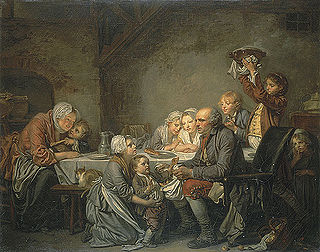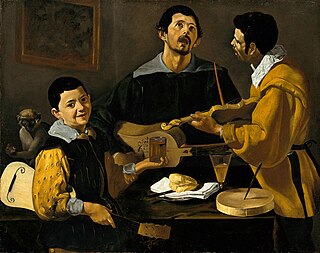 W
WMerry company is the term in art history for a painting, usually from the 17th century, showing a small group of people enjoying themselves, usually seated with drinks, and often music-making. These scenes are a very common type of genre painting of the Dutch Golden Age and Flemish Baroque; it is estimated that nearly two thirds of Dutch genre scenes show people drinking.
 W
WAssault of Thieves is an oil painting made by Francisco de Goya between 1793 and 1794. It is part of a private collection owned by Juan Abelló.
 W
WBoy Peeling Fruit is a painting by the Italian Baroque master Michelangelo Merisi da Caravaggio (1571–1610) painted circa 1592–1593.
 W
WChristmastide Divination is a painting by Russian artist Konstantin Makovsky from around 1905. The painting shows a moonlit Russian folk divination during Eastern Orthodox Christmastide (svyatki) in a rural log house (izba). Five out of seven depicted women gathered around a rooster pecking the grain, the alectryomancy which foretells a marriage in the near future. The girls count the grains pecked by the rooster, watching if he did not peck more than twelve. If the number of remaining grains would be even, then the marriage will happen soon, and if odd, then it will be in the next year. A sleeping elder woman is depicted sitting on a bench to the left. The upper left part of the painting shows a candlelit icon corner.
 W
WThe Crossing Sweeper is an 1858 painting by William Powell Frith which has been described as breaking "new ground in its description of the collision of wealth and poverty on a London street." Frith later painted several versions of the same subject, updating the fashions.
 W
WThe Farmers' Lunch is one of the earliest paintings by the Spanish artist Diego Velázquez. Painted in oil on canvas in 1618, it combines a still life of food and drink with a depiction of three comic farmers, whose physiognomy the artist studies closely. The composition shows a younger man gesturing with his right hand to reinforce the story coming from his half-open lips, and an older man listening attentively while holding his cup up to a woman so she can refill it with wine. The still life includes fish, bread, a carrot, a lemon, and a copper vessel.
 W
WFêtes Vénitiennes is a 1719 painting by Antoine Watteau, now in the Scottish National Gallery in Edinburgh, to which it was bequeathed in 1861 by Lady Murray of Henderland, widow of John Murray, Lord Murray. It takes its title from a 1732 engraving of the work by Laurent Cars and is derived from the Venetian styles of dress and dancing shown in the work, the former inspired by the commedia dell'arte. It belongs to the fêtes galantes genre created by Watteau.
 W
WHunter's Home is an 1826 oil painting by the Belgian artist Henry Voordecker. The painting depicts a hunter at home, surrounded by animals and members of his family; a typical genre painting. It is in the collection of the Rijksmuseum in Amsterdam.
 W
W"Jew with a coin", "little Jews", or "lucky Jew" are controversial images or figurines of a Jew holding a coin, usually accompanied by a proverb. The motif was first described in articles from 2000, and probably dates back to after the 1989 transition of Polish government. As of the early 21st century, they are found in shops and homes in Poland. According to a 2015 survey, 65% of respondents recognized the motif, 55% saw an item with the motif at the home of a family member or friend, and 18% of respondents had one themselves.
 W
WThe Kings' Tart or The Twelfth Night Cake is a 1774 genre painting by Jean-Baptiste Greuze, showing the French tart then traditionally baked for Epiphany to celebrate the arrival of the Three Kings. Since 1836 it has been in the Musée Fabre in Montpellier.
 W
WThe Kitchen Maid is one of two paired domestic paintings by Diego Rodríguez de Silva y Velázquez from his early Seville period. A wide range of dates has been suggested for its completion, although most place it between 1620 and 1622. This version is kept in the Art Institute of Chicago. The second version is held at the National Gallery of Ireland.
 W
WThe Kitchen Maid is a 1738 painting by Jean Simeon Chardin. The painting features a young kitchen maid in a Hollandish kitchen, taking a break from her work. The work was popular, and Chardin had made four different copies; with three of them present in various collections in the modern day.
 W
WThe Laundress is a 1761 genre painting by French artist Jean-Baptiste Greuze (1725-1805), existing in two versions. Its development was influenced by Dutch cabinet painting and the imagery of the laundress made popular through a literary style known as genre poissard. The prime version of The Laundress was one of fourteen works exhibited by Greuze at the Salon of 1761 and was part of the collection of Greuze's patron, Ange Laurent Lalive de Jully. The painting was mostly unknown for more than two centuries as it was purchased in 1770 by Gustaf Adolf Sparre and privately held in that Swedish art collection and rarely seen until it was acquired by the Getty Museum in 1983.
 W
WThe Lunch is a very early painting by Spanish artist Diego Velázquez, finished c. 1617. The work, an oil painting on canvas, is in the Hermitage Museum of Saint Petersburg.
 W
WLuncheon of the Boating Party is a painting by French impressionist Pierre-Auguste Renoir. Included in the Seventh Impressionist Exhibition in 1882, it was identified as the best painting in the show by three critics. It was purchased from the artist by the dealer-patron Paul Durand-Ruel and bought in 1923 from his son by industrialist Duncan Phillips, who spent a decade in pursuit of the work. It is now in The Phillips Collection in Washington, D.C. It shows a richness of form, a fluidity of brush stroke, and a flickering light.
 W
WMan Blowing on an Ember is an undated work by Matthias Stom, one of several the 17th-century Dutch artist produced on Sicily. Recorded in the Ruffo collection in Messina, it is now in the Palazzo Abatellis in Palermo
 W
WMidsummer Dance is an oil on canvas painting by the Swedish artist Anders Zorn from 1897. There are three versions of the painting, the most famous one is exhibited at Nationalmuseum in Stockholm. Another version, painted at the same time, is now exhibited at the Pushkin Museum in Moscow. A third version, commissioned by an American collector in 1903, is in a smaller format and in private ownership.
 W
WOld Woman Frying Eggs is a genre painting by Diego Velázquez, produced during his Seville period. The date is not precisely known but is thought to be around the turn of 1618 before his definitive move to Madrid in 1623. The painting is in the Scottish National Gallery in Edinburgh. Velázquez frequently used working-class characters in early paintings like this one, in many cases using his family as models; the old woman here also appears in his Christ in the House of Martha and Mary (1618). There is some dispute about what cooking process is actually depicted with some suggesting not frying but poaching, leading to an alternative title of the painting, Old Woman Cooking Eggs or Old Woman Poaching Eggs.
 W
WOmnibus is an oil on canvas painting by the Swedish artist Anders Zorn from 1891–1892. There are two versions of the painting, the first one is exhibited at Nationalmuseum in Stockholm and the second in Isabella Stewart Gardner Museum in Boston.
 W
WThe Quack Doctor is a panel painting by the Dutch artist Gerrit Dou from 1652. It depicts a crowd gathered around a quack doctor as he promotes his wares. Dou also paints himself leaning out the window with a palette in hand. By including himself in the composition, he contrasts the deceptions involved in painting with those of quack medicine. For Dou, the composition was a departure; he was known for niche pieces, which depict an interior framed by a window. The painting has been written about quite extensively and is among the best-known treatments of its subject.
 W
WShrovetide Revellers, also known as Merrymakers at Shrovetide, is a painting by the Dutch Golden Age painter Frans Hals, painted in around 1616–17. It is one of the earliest surviving works by Hals, and has been held by the Metropolitan Museum of Art, New York City since 1913. The painting shows people festivities at Shrovetide, an annual carnival of food and jollity which takes place before the Christian fasting season of Lent.
 W
WSleeping Girl or Young Woman Sleeping is an oil on canvas painting by an unknown 17th century artist active in Rome, sometimes dated to c.1620 and previously attributed to Theodoor van Loon or Domenico Fetti. It is now in the Museum of Fine Arts, which acquired it from the Esterházy family collection. Its catalogue number is 609.
 W
WThe Three Musicians is an oil painting by Diego Velázquez (1599-1660), a Spanish Baroque painter considered one of the great Spanish naturalists. It depicts three young men grouped around a dinner table playing music. It is painted in chiaroscuro, a Baroque painting technique that made use of the contrast between light and dark shadows to achieve a sense of volume.
 W
WTwo Children Teasing a Cat is a 1587-1588 oil on canvas painting by Annibale Carracci, now in the Metropolitan Museum of Art in New York, which acquired it in 1994.
 W
WThe Waterseller of Seville is the title of three paintings by Spanish artist Diego Velázquez, dating from 1618–1622. The original version is considered to be among the finest works of the painter's Seville period and is displayed in the Waterloo Gallery of Apsley House. The original version was painted by Velázquez when he was in his late teens or early twenties. Looking at this painting, there is an older man, a young boy, and a bystander in the background. The old man is handing the young boy a glass of water but, they never look at each other, nor do they make eye contact with the viewer.
 W
WWoman Cooking or The Cook is the modern title given to a circa 1625 oil on canvas genre painting by Bernardo Strozzi, produced in Genoa and still held in the Palazzo Rosso in the city, part of the Strada Nuova Museums. A second autograph version with various differences was in the painter's studio at his death and is now at the National Gallery of Scotland in Edinburgh.